Archeological sites offer pieces to the massive puzzle of human history. At Chimney Rock National Monument, nestled in the San Juan National Forest in Southwest Colorado, summer travelers touring between May 15 and September 30 can learn about the indigenous people who constructed rudimentary homes and ceremonial buildings centuries ago. The Ancestral Pueblo, the same native group that mysteriously left Mesa Verde, also resided beneath the twin pinnacles which are located 17 miles west of Pagosa Springs and about 20 miles east of Durango, Colorado. Archeologists have discovered more than 200 homes and ceremonial structures in this area. Approaching the monument, the two spires—Chimney Rock and Companion Rock—can be seen for miles.
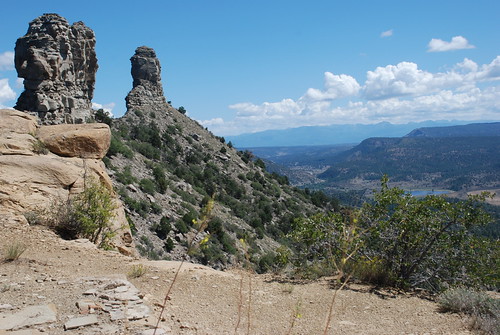
Chimney Rock and Companion Rock
ANCESTRAL PUEBLOS
Like other ancient cultures, the Pueblo people chose to build their communities along rivers. For the people who once lived in the shadows of Chimney Rock National Park, the San Juan and Piedra Rivers in Southwest Colorado were their source of water. Scientists have connected this group to the culture that was centered in Chaco Canyon, New Mexico, about 90 miles to the south. Artifacts found in both locations suggest that there was active trading between the sites as well as many others. Each of the outlier communities had a Great House, a Great Kiva, and roads leading back to Chaco Canyon. An onsite map illustrates a network of ancient roads connecting these villages.
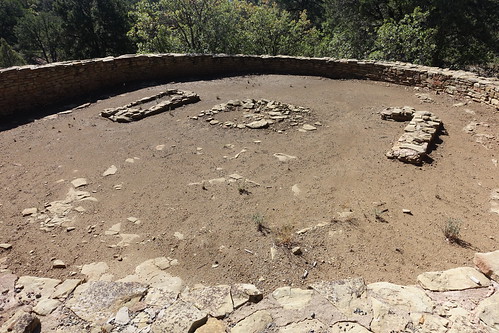
Chimney Rock Great Kiva with center fire pit and possible 2 foot drum on each side
By dating pottery fragments, scientists have determined that these people started living in the vicinity of Chimney Rock between 850-900 CE and mysteriously left in 1125. Similar to the Ancestral Pueblo at Mesa Verde, this group of Pueblo people departed without providing many clues. Archeologists have found related artifacts at Mesa Verde, at high mesas in northeastern Arizona, at the Galisteo Basin along the Rio Chama, and at the Rio Grande in New Mexico. Many of the Native Americans who live in these places can trace their heritage back to the people who once lived at Chimney Rock during the Pueblo II period from 900-1125.
Was climate change a factor? Had the people exhausted all of their natural resources? Could people not resolve leadership issues? Or maybe this group was only planning to stay for a short period before migrating further south to their ultimate destination. These are some of the leading theories suggested for their mysterious departure. With no written records, scientists and descendants of the Ancestral Pueblo can only hypothesize.
Stephen H. Lekson, curator of archaeology and professor of anthropology at the Museum of Natural History, University of Colorado, Boulder, noted, in his new book, A Study of Southwestern Archaeology, that "the Chaco Canyon culture was a stratified civilization, ruled by elites or royals who resided in great houses and towered over castes of commoners—literally, in the case of Chimney Rock."
CHIMNEY ROCK ADDED TO NATIONAL MONUMENT DESIGNATION in 2012
Even though Chimney Rock has a plethora of Native American history worth exploring, the area was not designated a national monument until President Barack Obama’s proclamation in 2012. The U.S. Forest Service works closely with 24 Native American tribes to maintain the integrity of this site. Chimney Rock National Park is just one of several places in the Four Corners region that showcase Native American culture and history.
WHAT TO SEE AT CHIMNEY ROCK NATIONAL MONUMENT
After stopping at the information center, it is necessary to drive up a 2-½ mile winding gravel road with switchbacks. Some of the people waiting inside the building opted to be driven up the hill by a park service employee.
Visitors can choose from two tour options or take a self-guided tour of just the Great Kiva Trail Loop. The one-hour tour is along the Pueblo Trail with an opportunity to view the remains of the Great House Pueblo while the two-hour tour includes the Pueblo Trail, the Kiva Trail, and four excavated structures. I recommend the second option for people who want to learn the most about this culture and can handle the 200-foot elevation climb on a rocky path.
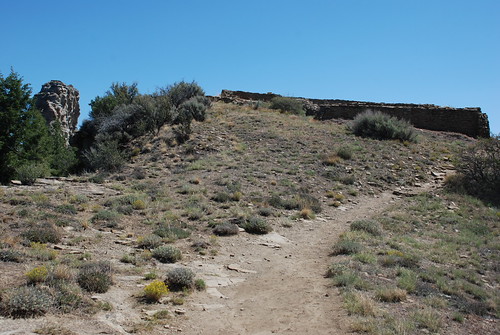
Chimney Rock Path
Our tour guide, John Richardson, told our group that both the local Pueblo people and the Chaco people lived in three distinct communities— the Lower Village, the Great Pueblo, and the Ridge House. The locals chose to live a distance away from Chimney Rock in a village with 18 masonry buildings and a Great Kiva. The Chaco people were divided between the two communities closest to the spires.
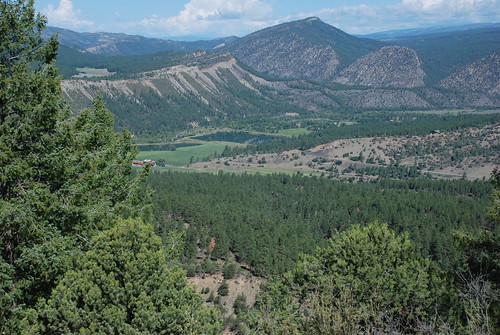
A View from Great Kiva Trail
The Great Kiva Trail Loop
This relatively flat, paved one-half mile trail was surrounded by drought-resistant vegetation, consisting mainly of piñon pine, juniper, and yucca plants. After a short distance, our small group came upon an overlook where we had a spectacular view of the Piedra River Valley and Peterson Ridge. We also stopped to look at the 44-foot diameter excavated Great Kiva (1084 CE) and an excavated pit house (1077 CE).
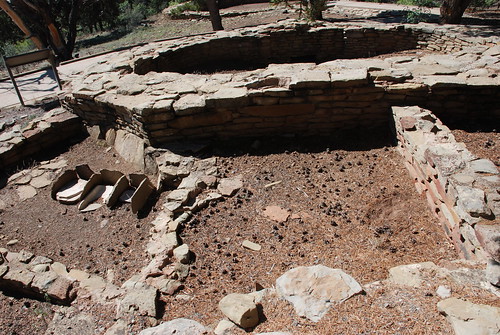
Chimney Rock Pit House
As we gazed into the Great Kiva, John mentioned that Kivas are another great mystery. Most believe that they were used for religious, spiritual, and social gatherings.
The pit house was excavated in the 1970s. Scientists believe that a family with 3-5 people resided in this primitive structure constructed of wooden poles, mud, and clay. A nearby diagram illustrated that the original structure had a flat roof made from an interwoven mat of sticks held in place by four upright wooden beams. The builders of the house included a ventilation system that prevented smoke from building up in the interior.
Pottery found at the site reveals clues about their diet, which was dependent on the three sisters—corn, beans, and squash—as well as their lifestyle. Their unbalanced diet is presumed to be the cause of a preponderance of arthritis and osteoporosis found in the skeletal remains.
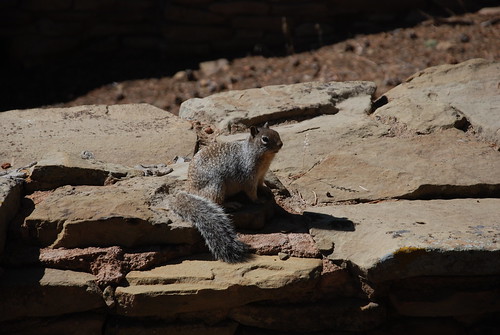
Squirrel Joining the Tour
As I stared into the simple building, I shook my head in disbelief. How did these people survive the extreme heat and dryness of the summers and the cold, snowy winters?
John interrupted my thoughts as he rattled off multiple ways that the native people used their natural surroundings to survive. I will definitely look at yucca plants differently, after learning about the various ways that the plant can be used.
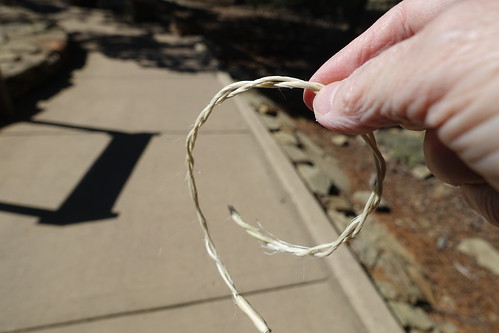
Cord made from Yucca Plant
Pueblo Trail
The Pueblo trail may be challenging for people who have yet to acclimatize to the mountain altitude (over 7,000 feet above sea level) or are uncomfortable walking on a steep terrain filled with uneven surfaces. Our guide adjusted the pace to accommodate the people who required additional time to scale the steeper segments of the 1/3-mile trail that leads to the Great House. The people who struggled later admitted that it was well worth the effort when they reached the remains of the 11th century Great House Pueblo.

Entrance to Great House Pueblo
Before this visit, I had never heard of the term archaeoastronomy, the study of the knowledge and practices of ancient cultures regarding sky phenomenon. The Ancestral Puebloans were sky watchers who tracked the movements of the sun, moon, stars, and planets. Based on their knowledge of the Northern Major Lunar Standstills (NMLS) that occurs every 18.6 years, it is believed that these people built the Great House as a place to witness the moonrise between the two spires. Two construction phases at the Great House Pueblo match up with the NMLS that occurred in 1076 and 1093 CE. The next NMLS event will take place in 2021.
John also mentioned another natural phenomenon that occurs each spring during the equinox when the sun rises between the spires and rays of sunshine fall upon the area referred to as Peterson Gulch. Back in the 11th century, the Pueblo people would congregate before sunrise at Peterson Gulch and admire this spectacular moment. A U.S. Forest Service document refers to annual summer solstice observances, as well.
To capitalize on the connection between the Earth and the sky at this unique site, the national monument offers Full Moon Programs and Night Sky Archaeoastronomy Programs once a month from mid-May until the end of September.
Thinking back to the time when the Great House was built, it’s hard to imagine how these people carried hundreds of thousands of blocks of stone up the hill and then put them methodically into place without the use of any modern technology. The remaining original stonework highlights the craftsmanship from the 11th century. All of this was accomplished on a hilltop without any water or crops.

Great House Pueblo
One cannot leave this national monument without a sense of awe and wonder. Centuries after the Ancestral Pueblos left the region, the surrounding landscape remains magnificent. Even though many gaps remain in our understanding of this indigenous people, visitors can marvel at their accomplishments and be inspired by their early knowledge of the solar system and how it affects life on Earth. As you plan your next summer vacation, remember that History Comes Alive at Chimney Rock National Park.
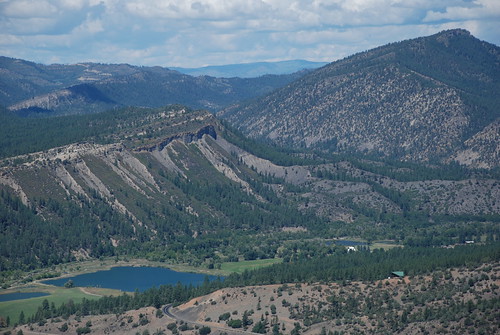
View from Pueblo Trail
Pin for later:
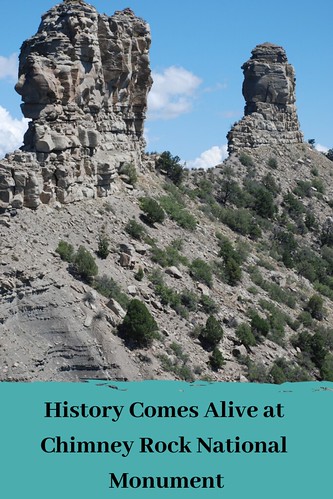
Sandy Bornstein, the History Comes Alive Through Travel Editor for Wandering Educators, has visited more than 40 countries and lived as an international teacher in Bangalore, India. Sandy’s award-winning book, May This Be the Best Year of Your Life, is a resource for people contemplating an expat lifestyle and living outside their comfort zone. Sandy writes about Jewish culture and history, historical sites, family, intergenerational, and active midlife adventures highlighting land and water experiences.
All photos courtesy and copyright Sandy Bornstein, except where noted.
